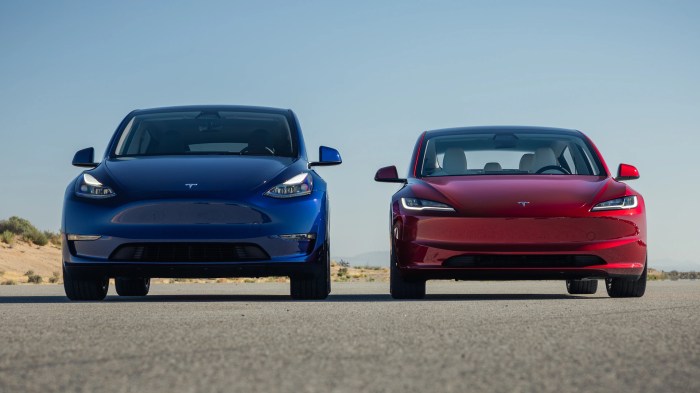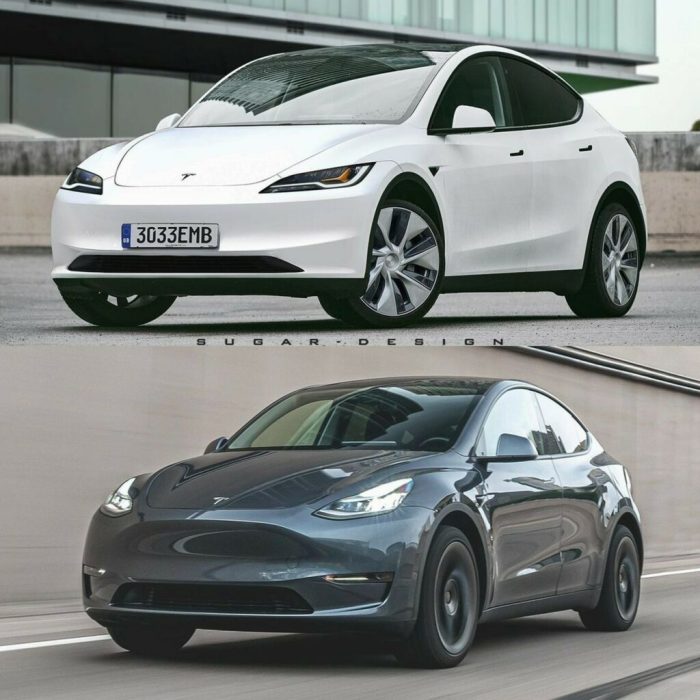The electric vehicle (EV) market is booming, and two prominent contenders vying for consumer attention are the Volkswagen e-Golf and the Tesla Model 3. While the e-Golf has since been discontinued, its legacy and comparison to the ever-evolving Model 3 remain relevant for understanding the EV landscape and consumer choices. This detailed comparison explores their key features, performance, technology, and overall value proposition in a 2025 context, considering the advancements and market shifts since the e-Golf’s discontinuation.
Performance and Range: A Tale of Two Eras
The VW e-Golf, even in its final iteration, offered a respectable range and performance for its time. However, compared to the Tesla Model 3 in 2025, the differences are stark. The Model 3 has consistently improved its range and acceleration capabilities through software updates and hardware refinements. Let’s break down the key performance metrics:

Source: motortrend.com
Range and Charging
- VW e-Golf (Discontinued): Offered a range of approximately 125-200 miles (depending on the model year and battery size), with charging times varying significantly depending on the charger type. Level 2 charging was relatively slow, while DC fast charging provided a quicker, albeit still lengthy, top-up.
- Tesla Model 3 (2025): The 2025 Model 3 boasts a significantly extended range, likely exceeding 300 miles on a single charge for many variants. Tesla’s Supercharger network provides considerably faster DC fast charging compared to the e-Golf’s charging options, significantly reducing charging times. Over-the-air updates continue to refine efficiency and range.
Acceleration and Handling
- VW e-Golf (Discontinued): Provided adequate acceleration for city driving, but lacked the exhilarating performance of the Model 3. Handling was competent but not particularly sporty.
- Tesla Model 3 (2025): Known for its impressive acceleration, especially in higher-performance variants. The Model 3 offers a more dynamic and engaging driving experience, with responsive handling and advanced features like Autopilot contributing to a superior driving feel.
Technology and Features: A Generational Leap
The technological gap between the e-Golf and the 2025 Model 3 is substantial. Tesla’s commitment to continuous software updates and innovative features places it far ahead in this area.
Infotainment and User Interface
- VW e-Golf (Discontinued): Featured a relatively basic infotainment system, though improved in later models. Integration with smartphones was present but not as seamless as in the Model 3.
- Tesla Model 3 (2025): Boasts a large, centrally located touchscreen that controls nearly all vehicle functions. The user interface is intuitive and constantly updated with new features. Over-the-air updates provide continuous improvements and additions.
Driver-Assistance Systems
- VW e-Golf (Discontinued): Offered basic driver-assistance features like adaptive cruise control and lane-keeping assist in higher trims. These were not as sophisticated or integrated as Tesla’s offerings.
- Tesla Model 3 (2025): Features Tesla’s Autopilot and Full Self-Driving Capability (FSD) options, providing advanced driver-assistance features such as automatic lane changes, traffic-aware cruise control, and parking assist. The level of autonomy offered by FSD is constantly evolving (though limitations remain).
Connectivity and Software Updates
- VW e-Golf (Discontinued): Connectivity features were limited, with updates typically requiring a dealership visit.
- Tesla Model 3 (2025): Offers over-the-air updates, meaning new features, performance enhancements, and bug fixes are delivered wirelessly, keeping the vehicle constantly updated.
Pricing and Value: Considering the Discontinued Model
The VW e-Golf, being discontinued, is now primarily available in the used car market. Its pricing will reflect its age and condition, making it a potentially more affordable option than a new Model 3. However, the overall value proposition shifts significantly when considering the technological advancements and improved performance of the Model 3. The Model 3’s higher initial cost is offset by its superior range, performance, technology, and potential for future value retention.
Environmental Impact: A Shared Commitment
Both the e-Golf and the Model 3 contribute to a reduced carbon footprint compared to gasoline-powered vehicles. However, the complete lifecycle environmental impact, including manufacturing and battery disposal, needs to be considered for a comprehensive assessment. Both manufacturers are working on improving sustainability across their operations.
Frequently Asked Questions (FAQ)
- Q: Is the VW e-Golf still available for purchase? A: No, the VW e-Golf has been discontinued. It is only available in the used car market.
- Q: How does the Tesla Model 3’s range compare to the e-Golf? A: The Model 3 offers significantly longer range than the e-Golf, often exceeding 300 miles compared to the e-Golf’s approximately 125-200 miles.
- Q: Which car has better technology? A: The Tesla Model 3 offers far more advanced technology, including a superior infotainment system, advanced driver-assistance features, and over-the-air updates.
- Q: Which car is more affordable? A: Used e-Golfs are likely more affordable than new Model 3s. However, the overall value proposition of the Model 3, considering its performance and features, needs to be assessed individually.
- Q: What about charging infrastructure? A: Tesla’s Supercharger network offers a significant advantage in terms of charging speed and convenience compared to the charging options available for the e-Golf.
Conclusion: Choosing Your Electric Future
The comparison between the VW e-Golf and the Tesla Model 3 in 2025 highlights the rapid evolution of the EV market. While the e-Golf served as a valuable entry point into electric mobility, the Model 3 represents a significant leap forward in terms of range, performance, technology, and overall driving experience. The best choice depends on individual needs, budget, and priorities.

Source: carscoops.com
Consider your driving habits, technological preferences, and desired range when making your decision.
References
- Tesla Model 3 Official Website
- Volkswagen Official Website (Note: e-Golf information may be archived)
- (Add other relevant sources such as automotive review sites and EV comparison websites)
Call to Action
Ready to explore your electric vehicle options? Research both new and used EVs to find the perfect fit for your lifestyle and budget. Contact a dealership or browse online resources for more detailed specifications and comparisons.
Question & Answer Hub
Will the VW e-Golf still be in production in 2025?
That’s uncertain. VW’s future production plans are subject to change, and the e-Golf’s lifespan may end before 2025. Check VW’s official announcements closer to 2025 for the most accurate information.
How will battery technology affect the range of these vehicles by 2025?
Expect significant range improvements in both vehicles by 2025 due to advancements in battery technology. However, the exact figures are speculative and depend on technological breakthroughs and specific model variations.
What about charging infrastructure improvements by 2025?
We anticipate a substantial expansion of fast-charging networks by 2025, making long-distance travel in both vehicles more convenient. However, the accessibility of these chargers will vary by region.
Will the price difference between the two remain significant in 2025?
The price gap might shift due to various factors including battery costs, production efficiency, and market competition. It’s difficult to predict precisely, but expect fluctuations.
